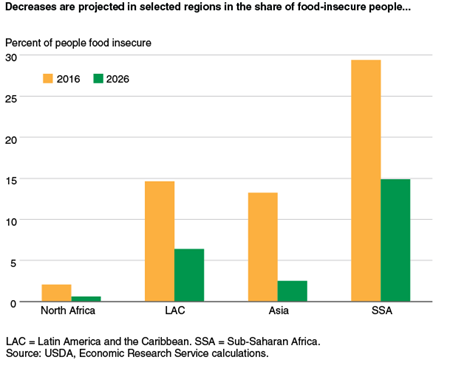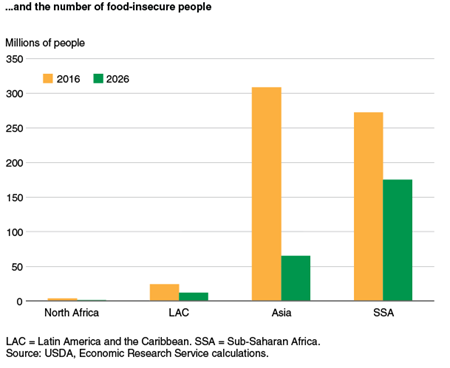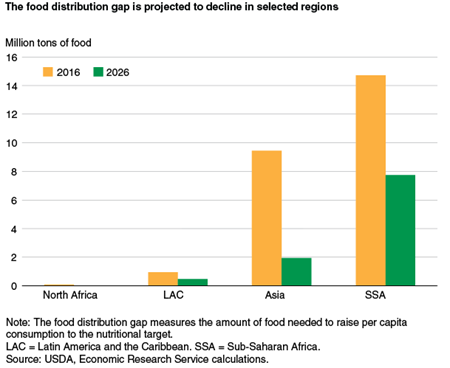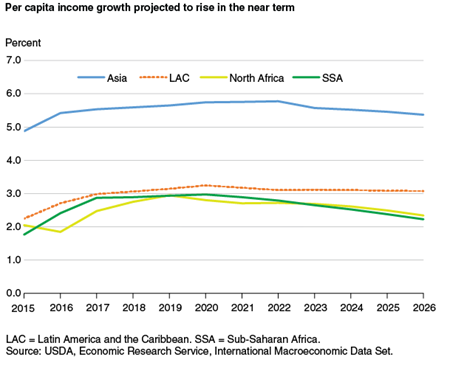Food Security of Developing Countries Expected To Improve Through 2026 as Food Prices Fall and Incomes Rise

Highlights:
-
Given projections for lower food prices and rising incomes, food security for 76 low- and middle-income countries is expected to improve during 2016-2026 as the number of food-insecure people falls by 59 percent and the share of the food-insecure population drops from 17 to 6 percent.
-
At the regional level, the greatest improvement is projected for Asia, where the number of food-insecure people falls by 80 percent; in Latin America and the Caribbean, the number is projected to fall by half, while Sub-Saharan Africa’s situation is expected to improve more slowly, with the number of food-insecure people falling by 36 percent.
-
These projections are a result of assumptions made in late 2015/early 2016; since that time, the outlook for income growth is not as optimistic as it was then, and there are signs that food prices might see a slight increase rather than a decline over the next decade.
The international food price spikes over the last decade highlighted the impact of price shocks on the food security, or the ability to access enough food for healthy living, of vulnerable populations. This, coupled with the recent availability of consumer price data in food-insecure countries, has been a motivating factor for ERS to develop a new tool to assess international food security.
ERS has transitioned to a new International Food Security Assessment framework that includes information on consumer responsiveness to changes in food prices and incomes. The model projects food consumption as it responds to movements in domestic prices and income. When the projected demand exceeds projected food production, the difference is referred to as the implied additional supply required. Projections are based on given income and price change expectations as well as fixed policy regimes through 2026. The difference between projected food production and food demand should not be interpreted as ”projected imports” as the difference may be reduced or eliminated by imports and/or improvements in agricultural productivity.
The model estimates per capita food consumption and evaluates that against a nutritional target of 2,100 calories per person per day to determine whether population groups should be considered food secure. It also estimates the food distribution gap, which measures the amount of food needed to raise consumption to the nutritional target. In many countries, consumption in the lower income groups is projected to be below the national average-consumption level. The distribution gap provides a measure of the intensity of hunger—the extent to which estimated consumption levels fall below the nutritional target.
According to price projections from USDA Agricultural Projections to 2025 and income projections from ERS’s International Macroeconomic Data Set, food prices will drop and income levels will rise over the next decade. Under these assumptions, model results suggest improvements in food security through 2026 for 76 low- and middle-income countries examined by ERS in a new report. The share of the total population of these countries that is food insecure is projected to fall from 17 percent in 2016 to 6 percent in 2026. Over the same period, the number of food-insecure people is projected to fall by 59 percent, from 609 million to 251 million. This decline matches the projected decline in the distribution gap, indicating no change in the intensity of food insecurity, at the aggregate level.
These food security projections are made under the assumption of projections for income and prices changes as of late 2015/early 2016. Since that time, world economic conditions and price and income outlooks have changed: the outlook for income growth is not as optimistic in mid-2016 as it was then, and there are signs that food prices might see a slight increase rather than a decline over the next decade. The projections presented here are dependent on continued political stability, investment in infrastructure, and maintenance of flows in remittances. Economic conditions in China play an important role as the country is a major trader and/or investor in infrastructure in many of the study countries. Finally, in addition to changes in food prices, movements in prices of other commodities play an important role in the food security picture. For example, the direction of oil prices is important for revenue for the oil exporters and for the import bill of the oil importers. All of these factors above can work to change—for better or worse—the food-security situation of the countries included in this article.
The model projects food demand for four separate food groups: major grains, all other grains, roots and tubers, and all other foods. Grains account for the bulk of the diet in most of the 76 countries. Of the major grains, corn is projected by USDA to have the fastest decrease in price, roughly 1.6 percent per year in real (inflation-adjusted) terms, over the next decade. Wheat prices and rice prices are projected to decline at annual rates of nearly 1.3 percent and 0.3 percent, respectively. Prices of cassava, a tuber that has seen rapid production growth, especially in Africa, are expected to decrease 1.6 percent per year through 2026.
Asia is expected to make the most progress
At the regional level, the greatest improvement in food security between 2016 and 2026 is projected for Asia, where the share of population that is food insecure falls from 13.2 to 2.4 percent and the number of food-insecure people falls nearly 80 percent. In 16 of the region’s 22 countries examined, less than 5 percent of the population is projected to be food insecure in 2026. Economic growth is projected to be strong in most countries in the South Asia subregion.
India, the most populous country among those examined in Asia (with just over half the region’s population), is expected to drive the overall improvement in food security, as food consumption is projected to rise rapidly in response to the assumption of the transmission of falling world prices to the local market and the region’s highest per capita income growth of nearly 7 percent per year. Recent economic growth in India was bolstered by declining oil prices and government investment in infrastructure.
The most food-insecure countries in Asia are North Korea, Yemen, Tajikistan, and Afghanistan. Of this group, Afghanistan is projected to see the greatest improvement in the share of food insecure people: from 38 percent in 2016 to less than 13 percent in 2026. This result is driven by the downward trend in the price of wheat, the country’s staple food, as well as a projected 3.2-percent annual increase in per capita income. Though it is also projected to show some improvement, North Korea will remain the most food-insecure country in the region, with 30 percent of its population consuming below the daily nutritional target.
Tajikistan’s average daily food consumption, roughly 2,100 calories per person in 2011 according to the Food and Agriculture Organization of the United Nations, is the lowest among the Commonwealth of Independent States (CIS) subregion in Asia. The share of the country’s population that is food insecure is projected to fall from 35 percent in 2016 to 19 percent in 2026, reflecting a decline in domestic wheat prices and a 1.4-percent annual increase in per capita income. The food-security situation of the other CIS countries is much better than that of Tajikistan; the share of the population in the other countries that is food insecure is projected to decline from 8 percent in 2016 to just over 3 percent in 2026. The improvements result from per capita income growth projections of over 3 percent per year. This growth will partly depend on whether and when economic growth in Russia will resume following the ongoing economic decline stemming from international sanctions and lower oil prices. The CIS countries depend on Russia for trade and remittances, which can boost incomes and, therefore, food demand.
Latin America and the Caribbean also projected to improve
The number of food-insecure people in the Latin America and the Caribbean (LAC) region is projected to fall by half over the next decade. As a result, the share of the region’s population that is food insecure falls from 14.6 percent in 2016 to 6.4 percent in 2026. The economic outlook for LAC is positive, with projected growth in Gross Domestic Product (GDP) of around 4.3 percent in South America and a slightly lower 3.6 percent in Central America and the Caribbean. This translates to rising per capita incomes, as LAC population growth is on a steady downward trend, projected to be just above 1 percent per year on average during the coming decade. Much of the positive economic outlook for Central America and the Caribbean is tied to U.S. economic growth, given that the U.S. is the region’s largest trading partner. U.S. demand for imports fuels the region’s exports, and remittances from the U.S. contribute to rising domestic demand. The South American countries are more dependent on exports of oil (Colombia and Ecuador) and copper (Peru), and their prospects are tied to prices of those commodities as well as the continued economic recovery in the U.S. and the EU, which are both major trading partners.
Strong food-security gains are expected throughout LAC with the exception of Haiti, where improvement is expected to be relatively modest. The country’s annual GDP growth of 3.4 percent translates to growth in per capita income of only 1.3 percent per year. As a result, food security in Haiti is projected to improve but not as strongly as in other countries in the region. The share of Haiti’s population that is food insecure falls from 50 to 39 percent over the decade. Bolivia is currently the most food-insecure country in South America, with 28 percent of its population projected as falling below the nutritional target in 2016. However, strong per capita income growth of roughly 3.5 percent per year is projected to reduce the share of the country’s food-insecure population to less than 9 percent in 2026.
Sub-Saharan Africa remains the most food insecure
Sub-Saharan Africa (SSA) is the most food-insecure region in the world. While the region accounts for 26 percent of the population of the 76 countries examined, it also accounts for an estimated 45 percent of the number of food-insecure people in 2016. And like the other regions, SSA’s food-security situation is projected to improve over the decade—but at a slower rate. The number of food-insecure people in SSA is projected to fall 36 percent by 2026, and the share of the region’s population that is food insecure is projected to fall from 29 to 15 percent. In 29 of the 39 SSA countries examined, 20 percent or less of the population is projected to be food insecure in 2026.
Sub-Saharan Africa is the world’s poorest region, but economic growth has averaged 5 percent per year over the last decade. This marks a considerable improvement from the 1990s when growth averaged less than 2 percent per year, resulting in declining per capita trends. This accelerated growth was largely due to improved governance; good weather, which resulted in the positive per capita grain output; and strong gains in prices for agricultural raw materials, the source of many countries’ exports. Regional GDP is expected to grow about 5 percent per year over the decade, and SSA’s population is expected to grow at roughly 2.5 percent per year, faster than that of any other region. However, this population growth is slow enough to allow for an increase in per capita incomes, which leads to improvements in food-security indicators for most countries in SSA. Strong growth and subsequent improvements in food security are expected for countries such as Cote d’Ivoire, Ethiopia, Mozambique, Rwanda, and Tanzania due to large-scale investment projects in energy and transportation, greater consumer spending in response to lower fuel prices, and increased mining output in several countries.
The projection of strong growth in SSA could be at risk given recent declining trends in prices for many primary commodities; political instability, including terrorist threats in several countries; and slow growth in China, the region’s largest single-country trade partner. If growth rates do fall short of projected levels, the positive food-security outlook for several of the SSA countries may be dampened as a result.
Among the SSA countries examined, only Eritrea, Sudan, Togo, Congo, and Chad are projected to have decreasing per capita incomes. In the case of Eritrea and Sudan, this leads to higher shares of food-insecure populations in 2026 (and worse levels of all food-security indicators). In Togo, Congo, and Chad, the declines in per capita income are projected to be more modest; that, combined with falling projected food prices in the three countries, is projected to bring a decline in the share of food-insecure people, although the absolute number is projected to rise.
Improvement in food security is also projected for North Africa, which is the most food-secure region examined. The share of North Africa’s population that is food insecure falls from 2.0 percent in 2016 to 0.6 percent in 2026. It is important to note that consumption levels in the region are high in part because of government programs that provide food subsidies to consumers. In recent years, when it became clear that the financial burden of these programs had become unsustainable, more targeted programs were implemented. As a result, average consumption levels of bread in North Africa have been reduced somewhat, but at the same time, a more diverse diet has been promoted. Food consumption levels in the region, in terms of calorie intake, continue to be comparable with those in high-income countries.
International Food Security Assessment, 2016-26, by Stacey Rosen, Karen Thome, and Birgit Meade, USDA, Economic Research Service, June 2016
A Consistent Food Demand Framework for International Food Security Assessment, by Birgit Meade, Stacey Rosen, and John Beghin, USDA, Economic Research Service, June 2015
Food and Agriculture Organization of the United Nations, FAOSTAT database, June 2016
Food and Agriculture Organization of the United Nations, The State of Food Insecurity in the World (SOFI), June 2015
USDA Agricultural Projections to 2025, by Paul Westcott and James Hansen, USDA, Economic Research Service, February 2016
World Bank, World Development Indicators database, June 2016





